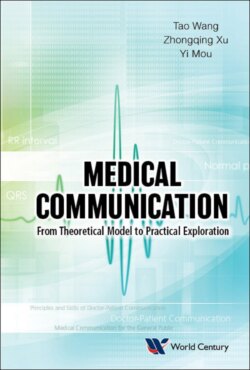Читать книгу Medical Communication: From Theoretical Model To Practical Exploration - Tao Wang - Страница 9
На сайте Литреса книга снята с продажи.
Chapter 1 Definition and Characteristics of Medical Communication
ОглавлениеFor thousands of years, people have gradually accumulated a wealth of medical knowledge in the battle against diseases and have spread the knowledge constantly in different ways. The medical knowledge has gradually developed into different medical systems. More than 2000 years ago, the ancient Greek physician, Hippocrates, the father of modern medicine, issued an oath that “in every house where I come I will enter only for the good of my patients, keeping myself far from all intentional ill-doing and all seduction and especially from the pleasures of love with women or men, be they free or slaves”. In Chinese history, the creation of five-animal boxing by the famous doctor in Han dynasty, Hua Tuo, and the popularization of Tusu wine by Sun Simiao, who is respected as the king of medicine, demonstrated the superb medical skills and effective means of dissemination of medical knowledge in the ancient China. Meanwhile, the ancients attached great importance to health education in the medical field. Huang Di Nei Jing, the first medical classic in the history of the Warring States period in China, stated: “The best doctor prevents illness, the better attends to impending sickness and the inferior treats existing illness.” What the sentence means is similar to the concept of disease prevention in modern medicine. It points out that it is more important to prevent diseases than to treat existing diseases and the subject of both treating diseases and preventing diseases is the doctor. Today in the age of communication technology explosion, on the one hand, we are in the age of information explosion, wandering among all kinds of unevenly sourced information. Neither does all medical information come from professional medical staff nor is all medical information true and reliable. On the other hand, the scientific literacy of citizens has not yet reached a high standard. According to the results of the Ninth China Citizens’ Scientific Quality Survey released by the China Association for Science and Technology in 2016, the proportion of citizens with science literacy in China is 6.2%. Although there has been a steady improvement compared with the past, compared with western developed countries, there is still a considerable gap, which means that at present in China, the vast majority of citizens do not yet have good scientific literacy. These reasons make it difficult for the citizens to effectively identify correct and useful medical knowledge from today’s explosive information flow. Citizens are more likely to be misled by fake news or misinformation, resulting in serious consequences. In recent years, the exposure of fake doctors such as Zhang Wuben and Liu Hongbin, as well as misdiagnosis caused by wrong information are all shown as typical cases. Therefore, in the field of medical communication, citizens generally call for the appearance of “professional team” (medical communication by professional medical personnel). At the same time, the communication practice of medical science popularization by medical staff also urgently needs the guidance of theory.
As a kind of practical activity, medical communication has a long history, but its emergence as an academic field has only recently begun. Medical communication originated from various disciplines such as medicine, history of science, philosophy of science, and communication, and has gradually formed its independent discipline system. We will introduce the definition of medical communication and distinguish its relationship with medical science popularization, health communication, and general science communication one by one. Meanwhile, the characteristics of medical communication will also be proposed.
